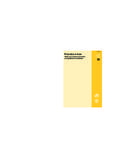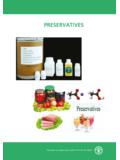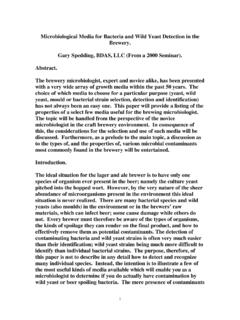Transcription of THE HOME WINEMAKERS MANUAL - Valley Vintner
1 THE HOMEWINEMAKERSMANUALLum EisenmanPREFACEMost home winemaking books are written like cookbooks. They contain winemaking recipes and step bystep directions, but little technical information is included. The goal of these books is to provide enoughinformation so the reader can make a successful batch of wine. Enology textbooks are the other extreme. They are very technical and can be difficult to comprehend without a background in chemistry andmicrobiology. These books are intended to give professional WINEMAKERS the specialized backgroundsneeded to solve the wide variety of problems encountered in commercial wine book is an attempt to provide beginning home WINEMAKERS with basic how to instructions as well asproviding an introduction to some of the more technical aspects of winemaking.
2 However, the technicalmaterial has been concentrated in a few chapters, so readers can easily ignore much of the technical contentuntil an interest you have a quantity of fresh grapes to convert into wine, read Chapter 1 and the first few pages ofAppendix A. This material will give you enough information to start a successful grape wine fermentation. Appendix A is written in a quasi outline form, and it provides a brief description of the entire winemakingprocess. If you have some fresh fruit and wish to make wine before the fruit spoils, read Chapter 21. This is a standalone chapter, and successful fruit wines can be made from the information provided here. The first fewpages provide enough information to prepare the fruit and start fermentation.
3 The rest of the chapter canthen be read at your 1, 2, 3, 4, 7, 8, 9, 10, 12, 14, 15 and 17 provide general information on home winemaking. These chapters discuss materials, facilities, equipment and basic processes. Much of this material is basicand should be of interest to most material presented in Chapters 5, 6, 11, 13 and 16 is a bit more advanced. These five chapters focusmostly on what and why rather than on how. Beginning WINEMAKERS may wish to skip these chaptersuntil they become more experienced. Chapters 18 and 19 are case studies of making a red and white wine. These two chapters provide adetailed chronology of the production of two typical 20 describes hot to make small quantities of sparkling wine, and Chapter 22, contains practical how to information of general 23 describes six common laboratory wine tests.
4 The significance of the tests, materials, apparatusand procedures are hope you enjoy my little book on home EisenmanDel Mar, 1998 TABLE OF CONTENTSC hapter 1. The Winemaking Process 1 Chapter 2. home Winemaking Costs 6 Chapter 3. Equipment and Facilities 9 Chapter 4. Winery Materials 17 Chapter 5. Sugars and Acids 23 Chapter 6. pH and Sulfur Dioxide 31 Chapter 7. Winery Sanitation 38 Chapter 8. Crush Season 44 Chapter 9. Harvest 49 Chapter 10. Grape Processing 54 Chapter 11. Wine Yeasts 61 Chapter 12. Primary Fermentation 65 Chapter 13. Malolactic and Other Fermentations 75 Chapter 14. Fining and Fining Materials 81 Chapter 15. Clarification and Stabilization 88 Chapter 16. Wine Filtration 97 Chapter 17. Bottling 101 Chapter 18.
5 Red Wine: A Case History 107 Chapter 19. White Wine: A Case History 112 Chapter 20. Making Sparkling Wine 117 Chapter 21. Making Fruit Wine 122 Chapter 22. Hints, Kinks and Gadgets 137 Chapter 23. Laboratory Wine Testing 147 Appendix A Step by Step Winemaking 156 Appendix B Conversion Factors 163 Appendix C Bibliography 165 Appendix D Sources 167 Appendix E Selected Wine Terms 168 ACKNOWLEDGMENTSMany people contributed to this book, and I greatly appreciate all their help. In particular, I wish to thankthe following people who expended much time and effort on my behalf. Thanks to Dr. Roger Seapy for critiquing the manuscript for technical content and for providing manycorrections and beneficial to Lynn Alley and Terry Whyte for reading the original manuscript and suggesting many usefulchanges in content, style and you Dr.
6 James Jenkins for many helpful technical discussions and suggestions for improving to Jim Graver for reviewing the chapter on fruit winemaking and providing many helpful you Duane DeBoer for reading the manuscript and making many technical suggestions from theperspective of a professional thanks Barbara Scherman for the many hours she spent attempting to untangle my inept 1 THE WINEMAKING PROCESSW inemaking can be divided into four basic phases. The first phase consists of finding a source of highquality fruit and making sure the grapes are harvested in an optimum condition. Buying small quantities ofhigh quality fruit is not easy, and this is the most difficult winemaking phase for home second phase consists of fermenting the grapes into wine.
7 WINEMAKERS manage the fermentation bycontrolling several different fermentation parameters such as temperature, skin contact time, pressingtechnique, the third phase, the new wine is clarified and stabilized. WINEMAKERS clarify wine by fining, rackingand filtration. Wine is stabilized by removing excessive protein and potassium hydrogen tartrate (potassiumbi-tartrate). These materials must be removed to prevent them from precipitating out of the wine the fourth phase of winemaking, the winemaker ages the wine. Most high quality wines are aged in bulkand then for an additional time in the bottle. WINEMAKERS have an active role throughout the lengthy bulkaging process. Wines are smelled, tasted and measured every few weeks, and any needed adjustments aremade for the first phase, the other three winemaking phases overlap each other.
8 New wine starts toclarify toward the end of the fermentation period. Some tartrates precipitate out during primaryfermentation, and the wine becomes more stable. Of course, wine is aging throughout the winemakingprocess. Each phase makes a specific contribution to wine characteristics, but the first phase has thegreatest influence on wine WINES AND WHITE WINESHigh quality, red wine grapes have colorless juice. All of the red color is in the grape skins, andwinemakers must leave the juice in contact with the skins for a considerable time to extract the color. Redwine is made by crushing the grapes and then fermenting the juice, the pulp, the skins and the seeds togetherfor several days. Near the end of sugar fermentation, a wine press is used to separate the liquid from thesolid wine is made by a different process.
9 First the grapes are crushed and pressed immediately toseparate the juice from the solids. After pressing, the skins, stems and seeds are discarded, and the juice iscooled to a low temperature. Then the cold juice is allowed to settle for several hours, and the clear juice2is decanted off the residue before it is fermented. White wine is made by fermenting clarified juice. Theseare the fundamental differences between making quality, red wine and white wine. At first glance, the twowinemaking processes may appear similar because several steps are identical. Nevertheless, the steps aredone in a different sequence, and the sequence makes a large change in wine characteristics. The twoprocesses are shown in Figure THE VINEYARDIt has often been said that wine quality is made in the vineyard, andfew experienced WINEMAKERS disagree with this statement.
10 Thesoil, climate, the viticulture and all other aspects of the vineyardenvironment contribute to the quality of the wine. Even if thewinemaker does a perfect job, the quality of the starting grapesalways determines the potential quality of the wine. Grape qualityis extremely important. Many WINEMAKERS feel that when a grapegrowing problem develops, the difficulty must be recognized andpromptly resolved to assure fruit quality. Consequently, both professional and amateur WINEMAKERS prefer to grow their owngrapes. Then they have complete control over the different fermentations occur in most red wines, and thesesame fermentations are often encouraged in heavier styled whitewines like Chardonnay or Sauvignon Blanc.







